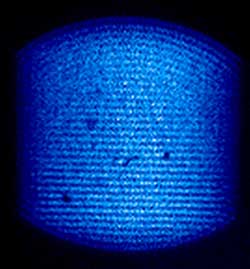Lab experiments mimic a star’s energy bursts

This false color image shows an ultracold plasma of 26,000 beryllium ions fluorescing when hit by a laser pulse.
A key process that enhances the production of nuclear energy in the interior of dense stars has been re-created in the laboratory for the first time by physicists at the National Institute of Standards and Technology (NIST). The work may help scientists study topics such as nuclear fusion as a possible energy source and demonstrates a new method for studying and modeling dense stellar objects such as white dwarfs.
The NIST experiments, described in the Jan. 18 issue of Physical Review Letters,* involve temperature measurements of ultracold crystals as they melt. First, a “plasma” of tens of thousands of singly charged beryllium atoms is trapped using electric and magnetic fields and then cooled to almost absolute zero using lasers. When the lasers are turned off, the plasma begins to heat up. At 10 milliKelvin—just 0.01 degree above absolute zero—the temperature suddenly rises more than 10 billion times faster than predicted by theory. This burst of energy in a very cold system of highly interactive particles is believed to mimic events occurring inside the hot, dense interiors of stars, where plasmas of highly charged atoms undergo accelerated nuclear reactions.
Beryllium ions are frequently used in NIST research on topics such as development of future atomic clocks and quantum computing studies. Such rapid heating was first noticed in experiments attempting to prepare special states of beryllium ions that can improve the precision of an atomic clock.
Scientists have suspected for decades that the fusion of atoms that powers stars is enhanced when the plasmas at their cores somehow reduce the natural repulsion between charged ions, increasing the chances that pairs of ions will collide and produce nuclear reactions. NIST researchers found that, at a certain temperature, their trapped beryllium ions also collided more frequently and that the plasma temperature suddenly shot up. In this case, the collisions resulted in a transfer of energy between two types of motions made by the ions.
Media Contact
More Information:
http://www.nist.govAll latest news from the category: Physics and Astronomy
This area deals with the fundamental laws and building blocks of nature and how they interact, the properties and the behavior of matter, and research into space and time and their structures.
innovations-report provides in-depth reports and articles on subjects such as astrophysics, laser technologies, nuclear, quantum, particle and solid-state physics, nanotechnologies, planetary research and findings (Mars, Venus) and developments related to the Hubble Telescope.
Newest articles

A universal framework for spatial biology
SpatialData is a freely accessible tool to unify and integrate data from different omics technologies accounting for spatial information, which can provide holistic insights into health and disease. Biological processes…

How complex biological processes arise
A $20 million grant from the U.S. National Science Foundation (NSF) will support the establishment and operation of the National Synthesis Center for Emergence in the Molecular and Cellular Sciences (NCEMS) at…

Airborne single-photon lidar system achieves high-resolution 3D imaging
Compact, low-power system opens doors for photon-efficient drone and satellite-based environmental monitoring and mapping. Researchers have developed a compact and lightweight single-photon airborne lidar system that can acquire high-resolution 3D…





















